#Fiber Electronics
Explore tagged Tumblr posts
Text
Fiber Optics Market to Reach $7.9B by 2032 at 8.1% CAGR
Meticulous Research®—a leading global market research company, published a research report titled, ‘Fiber Optics Market by Type (Single, Multi-mode), Material (Glass, Plastic), Deployment, Application (Internet & Computer Networking, Cable Television), End-user (IT & Telecommunications, Healthcare & Pharmaceuticals), and Geography - Global Forecast to 2032.’
According to this latest publication from Meticulous Research®, the global fiber optics market is projected to reach $7.9 billion by 2032, at a CAGR of 8.1% from 2025 to 2032.
The growth of this market is driven by the increasing demand for high-speed internet & data-intensive applications and the need to interconnect servers & data storage systems within data center facilities.
Additionally, technological advancements in telecommunications & networking, including FTTX, growing initiatives towards smart cities, and increasing need for high transmission rates & low-latency connectivity are expected to create market growth opportunities.
However, the extrinsic and intrinsic attenuation may restrain the growth of this market. The high cost of installation and associated complexities is a major challenge for the players operating in this market. Deployment of fiber optic cables in rural areas, growth of 5G communication networks & data centers, and advancements in wavelength division multiplexing (WDM) technology are prominent trends in the fiber optics market.
The global fiber optics market is segmented by type, deployment mode, organization size, application, and end-user industry. The study also evaluates industry competitors and analyzes the market at the region/country level.
Based on type, the global fiber optics market is broadly segmented into single-mode and multi-mode. The multi-mode type segment is further divided into step-index multimode cables and graded index multimode cables. In 2025, the single-mode segment is expected to account for the largest share of the global fiber optics market.
The large market share of this segment is attributed to the growing deployment of long-haul & metro city networks, increasing implementation of 5G networks, rising demand for low attenuation & dispersion, great data-transmitting capabilities, and increasing investments in the telecommunications sector. This segment is also projected to register the highest CAGR during the forecast period.
Based on material type, the global fiber optics market is broadly segmented into glass fiber optics and plastic fiber optics. In 2025, the glass fiber optics segment is expected to account for the largest share of the global fiber optics market. The large market share of this segment is attributed to the growing demand for higher information transmission with lower loss, rising demand for high-performance fiber optics in extreme temperatures & corrosive environments, and growing interconnected servers & data storage systems within data center facilities. This segment is also projected to register the highest CAGR during the forecast period.
Based on deployment mode, the global fiber optics market is broadly segmented into underground, underwater, and aerial. In 2025, the aerial segment is expected to account for the largest share of the global fiber optics market. This segment's large market share is attributed to the increasing technological advancements in telecommunications & networking, including Fiber to the X, growing demand for high-speed internet services, increasing adoption of faster & cheaper installation methods, and the growing importance of over-the-top (OTT) media services. This segment is also projected to register the highest CAGR during the forecast period.
Based on application, the global fiber optics market is broadly segmented into internet & computer networking, cable television, telephone, lighting & decorations, and other applications. In 2025, the internet & computer networking segment is expected to account for the largest share of the global fiber optics market.
This segment's large market share is attributed to the growing demand for network-connected devices across organizations to improve business communication and operation efficiency, the growing remote work culture, the rising penetration of the internet user base, the growing importance of networking, and the increasing need for more agile & efficient networking infrastructure. This segment is also projected to register the highest CAGR during the forecast period.
Based on end-user industry, the global fiber optics market is broadly segmented into IT & telecommunications, energy & power, aerospace & defense, healthcare & pharmaceuticals, manufacturing & industrial automation, building & construction, oil & gas industry, public sector, and others. In 2025, the IT & telecommunications segment is expected to account for the largest share of the global fiber optics market. The large market share of this segment is attributed to the increasing implementation of communication technologies such as 5G, IoT, and NB-IoT, rising demand for voice broadcasting, video streaming, & data sharing, growing need for greater bandwidth & faster speed connections, and rising penetration of mobile-phone & internet services.
However, the healthcare & pharmaceuticals segment is projected to register the highest CAGR during the forecast period due to the growing investment in medical equipment manufacturers & robots, increasing adoption of digital technology in healthcare, increasing demand for enhanced healthcare services, growing need to transmit healthcare data securely and efficiently, and increasing need for secure internet connections to ensure that patient data is transmitted quickly and securely.
Based on geography, the global fiber optics market is segmented into Asia-Pacific, Europe, North America, Middle East & Africa, and Latin America. In 2025, Asia-Pacific is expected to account for the largest share of the global fiber optics market, followed by Europe, North America, Latin America, and the Middle East & Africa. The large market share of Asia-Pacific is mainly attributed to the growing deployment of broadband network platforms in IT & telecommunications and administrative sectors, increasing implementation of fiber-integrated infrastructure, growing government initiatives to improve rural infrastructure and affordable high-speed internet, and growing need for Internet of Things (IoT) & connected devices across APAC region including China, India, & Japan. The region is also projected to register the highest CAGR during the forecast period.
Key Players:
The key players operating in the fiber optics market include Prysmian S.p.A. (Italy), Corning Incorporated (U.S.), Sumitomo Electric Industries, Ltd. (Japan), Fujikura Ltd. (Japan), LEONI Kabel GmbH (Germany), LS Cable & System Ltd. (South Korea), Hengtong Group (China), Furukawa Electric Co., Ltd. (Japan), CommScope Holding Company, Inc. (U.S.), Finolex Cables Ltd. (India), Proterial Cable America, Inc. (U.S.), Sterlite Technologies (India), Yangtze Optical Fibre and Cable Joint Stock Limited Company (China), Optical Cable Corporation (U.S.), OFS Fitel, LLC (U.S.), Aksh Optifibre Limited (India), FiberHome Telecommunication Technologies Co., Ltd. (China), Belden Inc. (U.S.), TE Connectivity Ltd. (Switzerland), Fibertronics, Inc. (U.S.), Infinera Corporation (U.S.), Nexans S.A. (France), Molex, LLC (U.S.), Extron (U.S.), Pepperl+Fuchs (India) Pvt. Ltd. (India), America Fujikura Ltd. (U.S.), Geokon, Inc. (U.S.), and Avantes B.V.(Netherlands).
Download Sample Report Here @
Key questions answered in the report:
Which high-growth market segments are based on type, material type, deployment mode, application, end-user, and geography?
What was the historical market for fiber optics?
What are the market forecasts and estimates for 2025–2032?
What are the major drivers, restraints, opportunities, challenges, and trends in the fiber optics market?
Who are the major players, and what shares do they hold in the fiber optics market?
How is the competitive analysis in the fiber optics market?
What are the recent developments in the fiber optics market?
What strategies are adopted by the major players in the fiber optics market?
What are the key geographic trends, and which are the high-growth countries?
Who are the local emerging players in the fiber optics market, and how do they compete with the other players?
Contact Us: Meticulous Research® Email- [email protected] Contact Sales- +1-646-781-8004 Connect with us on LinkedIn- https://www.linkedin.com/company/meticulous-research
#Fiber Optics Market#Fiber Optic Cable#Fiber Electronics#Fiber Network#Fiberoptic#Fiber Optic Broadband
1 note
·
View note
Text

Chip-free wireless sensors could reduce environmental impact of electronic tags
A more sustainable new form of electronic tag could help reduce the vast environmental impact caused by single-use RFID technologies, researchers say. Engineers from the University of Glasgow have developed the new wireless tag system, which can identify objects and measure temperature without the use of microchips. Instead, the tags use inexpensive coils and a sensing material made from a form of silicon rubber called PDMS and carbon fibers. The coils, smaller than the ones found in credit cards, absorb electromagnetic signals from a hand-held reader using electromagnetic waves. The researchers say their new, less wasteful tags could help reduce the retail sector's reliance on RFID chips, which uses more than 10 billion tags each year. Most tags are used just once, and end up in a landfill without appropriate recycling of the electronics.
Read more.
#Materials Science#Science#Sensors#Electronics#Environment#University of Glasgow#Temperature#Polydimethylsiloxane#PDMS#Carbon fibers#Fibers#Carbon
9 notes
·
View notes
Text
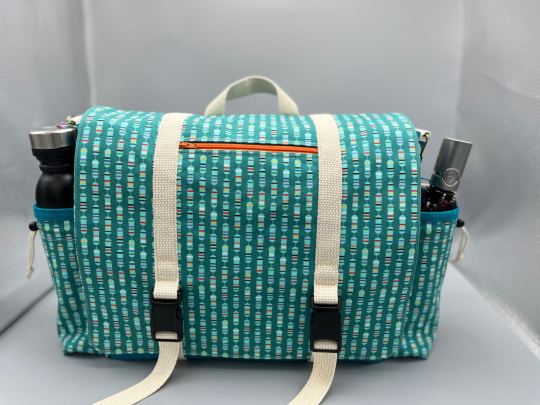




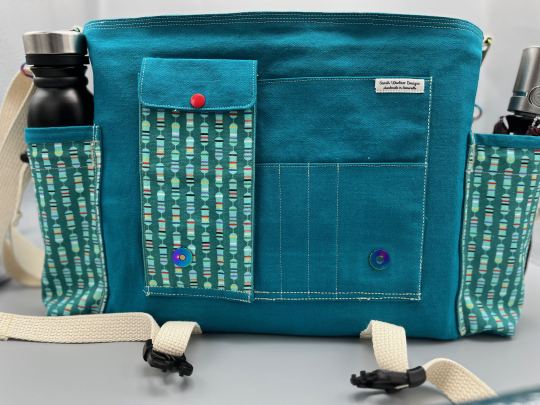






So. I swear to all the gods that this bag was not nearly so topical when I started working on it, but: here we are. Again. Still. We never stopped being here, but the here-ness of it is once again a full swarm of voracious locusts, and we are in it fully.
I am doing distinctly Not Great With Everything for all the reasons one might expect, but I could do worse than channeling it into making beautiful practical things so that's what I'm doing.
Ursula K. Le Guin speaks my mind: "I am an aging, angry woman laying mightily about me with my handbag, fighting hoodlums off. However I don't, nor does anybody else, consider myself heroic for doing so. It's just one of those damned things you have to do in order to be able to go on gathering wild oats and telling stories."
Keep doing the damned things. Take care of yourselves. Take care of each other.
Surface design by Robyriker / Elishka Jepson printed by Spoonflower Bag design by Sarah Wachter
Carrier Bag for Collective Resistance: https://rhymes-with-doctor.myshopify.com/products/collective_resistance
#handmade#handmade bag#messenger bag#sewing#sewblr#small business#my art#bag#spoonflower#electronics#fiber art
4 notes
·
View notes
Text
Making 32 bespoke hand crafted bits.
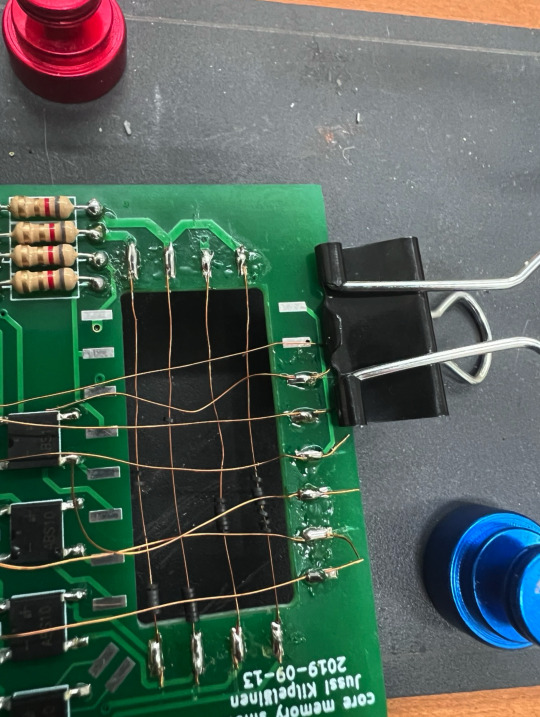
Hand made bits are so much nicer than store-bought bits.
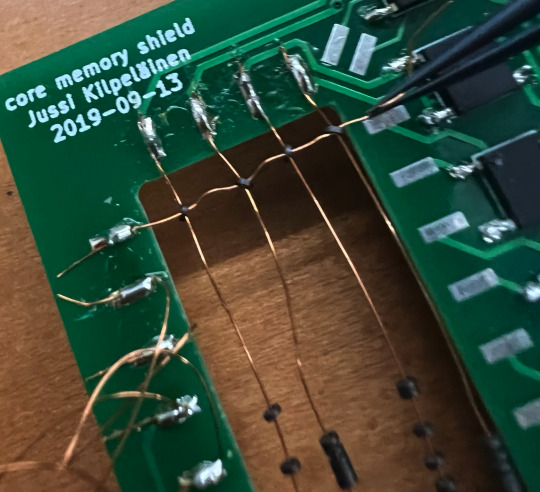
In the early days of woven core memory they sent it off to women to weave because the dudes took one look at it and thought “this is girl stuff like sewing and weaving”
I find this hilarious.
Here is a link (cued to the time where it starts) of the best and most clear explanation of how core memory works. Reading & writing a bit has many steps!
I always felt there was something poetic about how one must destroy this kind of memory in order to read it. Observation is never passive... to observe a system is to change it...
#core memory#ferrite core#arduino#arduino shield#bits and bytes#computer memory#CS#computer history#women's history#weaving#textiles#textile arts#fiber crafts#soldering#electronics
17 notes
·
View notes
Text
WESAF Electronic Component Cleaner Spray – Precision Cleaning for PCBs, Optics & Electronics | Buy Online in India
Maintain top performance of your electronic devices with WESAF Electronic Component Cleaner Spray – the ideal solution for cleaning dust, dirt, and contaminants from PCBs, fiber optic connections, and other sensitive components. Engineered for industrial and IT maintenance, this spray is safe on most plastic surfaces, leaves no residue, and offers non-conductive cleaning that professionals trust.
Whether you're in electronics manufacturing, computer repair, or industrial services, WESAF keeps your components clean and safe – Made for India’s tech needs.
🛒 Buy Now on Amazon: https://amzn.in/d/ix0BKhm 🌐 Visit Website: www.wesaf.in 📩 Contact Sales: [email protected]
#wesaf#electronic component cleaning spray#non-conductive cleaner spray#safe plastic electronics cleaner#buy PCB cleaner online India#industrial electronics cleaner India#circuit board cleaner spray#PCB contact cleaner aerosol#electronics spray for PC cleaning#fiber optic connector cleaning spray#electronic cleaning spray for laptop
0 notes
Text
yk… ykkk… yk what would like… be like.. cool… yk like… oh yk…
******SLY COOPER FUCKING FIVE….*******
#PLEAAASEEEE?????#ITSS BEEN 13 YEARS DADDY.. I REALLY REALLY MISS YOU… /Ref#JEESZSUUUUSSSS#and all you ratchet and clank fans with your new shiny PS5 game ehh ehh ehh WE DESERVED THAT AND MOOOREEE#but NOOOOO sucker punch wants to forget WHO MADE THEM. And be all “ehhh mimimi ghost of yotei” GHOST OF DEEZ FUCKING NUTS!!! GHOST!! OF!!!#THEEESSSSEEE!!! FUCKING!!!! NUTS!!!!!!! THE SLY COOPER MOVIE?? CANCELLED WITHOUT WARNING.. OHH OHH BUT OFF COUUURSE SONY!! GO MAKE SOME#FUCKING GHOST OF TSUSHIMA WHATEVER MOVIE THAT ***NO. ONE. WANTED***#DO THEY FORGET??? DO THEY??#THEY WOULD STILL BE MAKING FUCKING N64 NO NAME GAMES (no offense rocket ily) IF IT WERENT FOR SLY.. THEY WOULD BE NOTHING. SLY *MADE* THEM#AND THEY THROW THE SERIES AWAY LIKE ITS NOTHING…#Sorry i have no fucking clue what happened the tags tweaked out idk if the blank ones will show (anyways)#DONT. EVERRRRR PMOOO!!!!!!! I SWEAR TO GOD.. all the merch drops the rumours the clickbait videos the hope the loss the fan games??#EVERYTHING. Has been cancelled been put on hold been shut down without notice HISTORY. ALWAYS. REPEATS ITSELF. WHY.. FOR THE LOVE OF ACTUAL#GEN-YOU-EINE LOVE OF GOD JUST GET WHAT WE **DESERRRRVEEEEE**#13. YEARS. 13 YEARS.#I REMEMBER BEING A KID TALKING TO MY DAD AND GOING “maybe sly 5 will come out on the ps4” THAT WAS LIKE 2013-2014 ITS GODDAMN 2025. 2025#GTA 6 BEFORE SLY FUCKING 5 IS OUTRAGEOUS#NOW YOU NORMIES KNOW HOW IT FEELS TO WAIT YOUR ENTIRE LIFE FOR SOMETHING THAT WILL NEVER COME#I COULD RE-ENACT THE ENTIRE GAME IF I REALLY WANTED TO BY MYSELF NO ELECTRONICS. I COULD GIVE EXTREMELY#DOWN TO THE POINT. **MASTER-LEVEL** ANALYSIS OF *EVERY* LEVEL AND GIVE ABSOLUTE PICTURE-PERFECT DETAIL ON ABSOLUTELY *ANYTHING* POSSIBLE#IN THOSE GAMES.#IF I WAS LAYING I. MY FUCKING CASKET. DEAD AS SHIT. AND YOU PLAYED THE THIEVIUS RACCOONUS CREDITS. OR ANY ELSE IN THE GAME. I SWEAR TO *GOD#I WOULD FUCKING *RISE.* I WOULD BE ALIVE. HEALTHY. AND WELL. I PROMISE YOU.#IF I HAD AMNESIA. AND YOU PLAYED ME “slyy!! Come in!! Slyyyy!!! Do you read me!!” I WOULD ACTIVATE LIKE A FUCKING SLEEPER AGENT.#LIKE A TRUCK HITTING A BRICK WALL AT THE HIGHEST SPEED AN AUTOMOBILE IS PHYSICALLY CAPABLE OF. I WOULD REMEMBER *EVERYTHING* IN AN INSTANT.#THAT SERIES HAS LITERALLY SHAPED ME AS A PERSON. IT WAS. IS. HAS BEEN. AND FOREVER-FUCKING-WILL-BE MY MOST FAVORITE THING GENUINELY IN THE#ENTIRE. FUCKING. WORLD. IN THE ENTIRE FUCKING ULTRA-GALAXY. AND I MEAN THAT WITH EVERY FIBER OF MY SOUL. I CAN NOT LITERALLY COMPREHEND JUS#HOW MUCH LOVE I HAVE FOR THE SERIES AND EVERYTHING ITS STOOD FOR AND BEEN#SO FOR SONY. SUCKER PUNCH. AND WHOEVER ELSE. TO *CAST* IT AWAY LIKE A ROTTEN DECREPIT PILE OF *FILTH* JUST EVISCERATES ME TO GENUINELY#THE DEEPEST. DARKEST. PITS OF MY SOUL. OF MY VERY BEING. OF MY CONSCIOUS. MY SUB-CONSCIOUS. AND MY ESSENCE. IT DESTROYS ME. IT IS UNBECOMIN
1 note
·
View note
Text
Mitochondrial Dysfunction in Beckers Muscular Dystrophy

Introduction
Beckers Muscular Dystrophy (BMD) is a genetic neuromuscular disorder caused by mutations in the DMD gene, leading to defective dystrophin production. While dystrophin primarily serves as a structural protein, emerging evidence indicates its role in mitochondrial function and cellular metabolism. This article explores mitochondrial dysfunction in BMD, focusing on bioenergetics, oxidative stress, mitochondrial dynamics, and metabolic consequences.
Bioenergetic Impairment
Mitochondria are the primary energy-producing organelles, generating adenosine triphosphate (ATP) through oxidative phosphorylation (OXPHOS). In BMD, mitochondrial bioenergetics are disrupted due to reduced dystrophin-associated glycoprotein complex (DGC) stability, affecting intracellular signaling and energy metabolism. Studies show that muscle fibers from BMD patients exhibit reduced ATP production, mitochondrial membrane potential (ΔΨm) depolarization, and decreased respiratory chain efficiency. Impaired complex I and complex IV activities have been reported, contributing to decreased oxidative phosphorylation and subsequent muscle weakness.
Oxidative Stress and ROS Accumulation
Mitochondria are a significant source of reactive oxygen species (ROS), which play dual roles as signaling molecules and contributors to oxidative damage. In BMD, excessive ROS production due to dysfunctional electron transport chain (ETC) exacerbates oxidative stress. Studies have demonstrated elevated lipid peroxidation, increased protein carbonylation, and mitochondrial DNA (mtDNA) damage in BMD-affected muscles. Reduced expression of key antioxidant enzymes, such as superoxide dismutase (SOD) and glutathione peroxidase (GPx), further impairs the ability to counteract oxidative damage. The resulting oxidative burden contributes to muscle fiber degeneration, chronic inflammation, and apoptosis.
Mitochondrial Dynamics: Fission and Fusion Imbalance
Mitochondria continuously undergo fission and fusion processes to maintain cellular homeostasis. These dynamics are critical for mitochondrial quality control, ensuring the removal of damaged mitochondria via mitophagy. In BMD, an imbalance between fission and fusion leads to mitochondrial fragmentation and defective turnover. Key regulators such as dynamin-related protein 1 (DRP1) and mitofusin-2 (MFN2) exhibit altered expression, resulting in increased mitochondrial fission and reduced fusion. This dysregulation impairs mitochondrial network integrity, contributing to decreased ATP production and enhanced susceptibility to apoptosis.
Calcium Homeostasis and Mitochondrial Dysfunction
Dystrophin deficiency in BMD disrupts sarcolemmal stability, leading to aberrant calcium (Ca²⁺) handling. Elevated intracellular Ca²⁺ levels induce mitochondrial Ca²⁺ overload, impairing bioenergetic function and promoting mitochondrial permeability transition pore (mPTP) opening. mPTP dysregulation results in mitochondrial swelling, cytochrome c release, and apoptotic cascade activation. Additionally, excessive mitochondrial Ca²⁺ uptake alters ATP synthesis efficiency, exacerbating muscle fiber necrosis and degeneration.
Metabolic Alterations and Energetic Deficits
Skeletal muscle metabolism in BMD is characterized by a shift from oxidative to glycolytic energy production. Defective mitochondrial respiration forces muscle fibers to rely on glycolysis for ATP generation, leading to increased lactate accumulation and metabolic acidosis. This metabolic shift results in early fatigue, reduced endurance, and inefficient energy utilization. Transcriptomic analyses have identified downregulation of genes involved in fatty acid oxidation and tricarboxylic acid (TCA) cycle activity, further confirming the metabolic shift towards glycolysis. Such metabolic alterations compromise muscle function and regeneration capacity, contributing to disease progression.
Mitochondrial Quality Control and Mitophagy Defects
Mitophagy, a selective form of autophagy responsible for degrading damaged mitochondria, is impaired in BMD. The PINK1/Parkin pathway, essential for mitochondrial quality control, is downregulated in dystrophic muscle, leading to the accumulation of dysfunctional mitochondria. Defective mitophagy contributes to mitochondrial swelling, increased oxidative stress, and cellular energy deficits. Additionally, impaired mitophagy reduces the capacity for mitochondrial biogenesis, further exacerbating mitochondrial dysfunction and muscle pathology.
Conclusion
Mitochondrial dysfunction in BMD arises from bioenergetic impairments, oxidative stress, disrupted mitochondrial dynamics, altered Ca²⁺ homeostasis, metabolic deficits, and defective mitophagy. These abnormalities collectively contribute to muscle degeneration and disease progression. Understanding these mitochondrial defects provides valuable insights into the pathophysiology of BMD, emphasizing the need for targeted researc
h to mitigate mitochondrial dysfunction and improve muscle health in affected individuals.
#Beckers Muscular Dystrophy#Mitochondrial dysfunction in BMD#Oxidative stress in muscular dystrophy#Mitochondrial bioenergetics in BMD#ATP production in muscle disease#Reactive oxygen species (ROS) in BMD#Electron transport chain dysfunction#Mitochondrial DNA damage in BMD#Calcium homeostasis in muscular dystrophy#Mitochondrial fission and fusion imbalance#Mitophagy defects in BMD#Muscle fiber degeneration in BMD#Glycolytic metabolism in muscular dystrophy#Mitochondrial membrane potential disruption#Sarcolemmal instability in BMD#Superoxide dismutase (SOD) in muscle health#Mitochondrial permeability transition pore (mPTP)#Fatty acid oxidation in muscle disease#Dystrophin-associated glycoprotein complex (DGC)#Metabolic deficits in Beckers muscular dystrophy
0 notes
Text

#DSC_6049#technology#server room#server farm#central apparatus room#network operations center#fiber optics#broadcasting#computers#electronics#storage#binary#2008#Nikon D70s#[upl]
1 note
·
View note
Text
Mechanical properties and application scenarios of FR4 epoxy glass fiber board
In the electronics industry, printed circuit boards (PCBs) are core components that connect various electronic components, and their quality and performance are directly related to the stability and reliability of the entire electronic equipment. In the manufacturing process of PCBs, the selection of substrate materials is particularly critical. FR4 epoxy glass fiber board, as a widely used PCB…
#application scenarios#automotive electronics#communication equipment#consumer electronics#dimensional stability#FR4 epoxy glass fiber board#high strength#impact resistance#industrial control#mechanical properties#rigidity#wear resistance
0 notes
Text
Bio Based Leather Market Size, Share, Trends, Opportunities, Key Drivers and Growth Prospectus
"Bio Based Leather Market – Industry Trends and Forecast to 2029
Global Bio Based Leather Market, By Source (Mushroom, Pineapple, Cork, Leftover Fruits, Others), Application (Footwear, Furnishing, Automotive, Clothing, Bags and Wallets, Sports, Electronics, Others), By Sales Channel (Online, Offline) – Industry Trends and Forecast to 2029
Access Full 350 Pages PDF Report @
**Segments**
- **Material Type**: The bio-based leather market can be segmented based on the material type, including mushroom leather, pineapple leather, apple leather, and others. Mushroom leather, also known as mycelium leather, is a sustainable alternative to animal leather made from mycelium cells. Pineapple leather, also called Pinatex, is made from the fibers of pineapple leaves, offering a cruelty-free and eco-friendly option. Apple leather is a byproduct of apple juice production, utilizing the discarded skin and cores to create a leather-like material. These material types cater to the increasing demand for sustainable alternatives in the fashion and automotive industries.
- **End-Use Industry**: Another crucial segmentation of the bio-based leather market is based on end-use industries, which include fashion, automotive, furniture, and others. In the fashion industry, bio-based leather is gaining popularity among environmentally conscious consumers and ethical fashion brands looking for sustainable materials. The automotive sector is also adopting bio-based leather for interior applications, reducing the carbon footprint of vehicles. Similarly, the furniture industry is incorporating bio-based leather for upholstery and interior décor, driving the demand for eco-friendly materials in the market.
**Market Players**
- **Bolt Threads**: Bolt Threads is a major player in the bio-based leather market, known for its innovative mycelium-based leather called Mylo. The company has partnered with renowned fashion brands to introduce sustainable leather products to the market, catering to the growing demand for eco-friendly alternatives in the fashion industry.
- **Ananas Anam**: Ananas Anam is a leading provider of pineapple leather, marketed under the brand name Pinatex. The company has collaborated with various fashion and accessory brands to offer cruelty-free and sustainable leather alternatives, contributing to the circular economy and responsible sourcing practices in the fashion industry.
- **Frumat**: Frumat is a key player in the apple leather segment, specializing in transforming apple waste into leather-like material for various applications. The company's eco-friendlyFrumat has made significant strides in the bio-based leather market by utilizing apple waste to create a sustainable alternative to traditional leather. The process of transforming apple byproducts into leather-like material not only reduces waste but also offers a cruelty-free option for consumers looking for eco-friendly choices in the fashion and accessories industry. Frumat's innovative approach to repurposing fruit waste showcases the potential for circular economy practices in the fashion sector, highlighting the importance of sustainability and responsible sourcing.
As consumer awareness and demand for sustainable products continue to rise, companies like Frumat play a pivotal role in driving the adoption of bio-based leather materials in various industries. The unique selling proposition of apple leather, with its environmentally friendly production process and resourceful use of agricultural waste, positions Frumat as a key player in the market. By providing a renewable and biodegradable alternative to traditional leather, Frumat contributes to the shift towards more sustainable practices in the fashion and accessories market.
Furthermore, the collaboration of Frumat with fashion brands and manufacturers to incorporate apple leather into their product lines showcases the versatility and adaptability of this bio-based material. As the push for more sustainable and ethical fashion choices gains momentum globally, Frumat's apple leather presents a compelling option for companies seeking to align with consumers' preferences for eco-conscious products. The expansion of apple leather into new applications and industries demonstrates the market potential and growth opportunities for bio-based materials in the broader context of sustainability and responsible consumption.
In addition to addressing environmental concerns, the production of apple leather by Frumat also offers economic benefits by utilizing agricultural byproducts that would otherwise go to waste. This circular approach to materials sourcing contributes to a more efficient and resourceful supply chain, while also creating opportunities for innovation and value creation in the bio-based leather market. As Frumat continues to refine its processes and expand its product offerings, the company is well-positioned to capture a larger share of the growing demand for sustainable alternatives in the global fashion and accessories industry.
Overall, Frumat's focus**Market Analysis**
In the evolving landscape of sustainable materials, bio-based leather has gained significant traction as a preferred alternative to traditional leather, driven by environmental concerns and ethical considerations. With a focus on eco-friendliness and cruelty-free production, bio-based leather made from sources like mushrooms, pineapples, and apples has emerged as a viable solution for industries seeking to reduce their carbon footprint and embrace sustainable practices. The market players, including Frumat, have played a crucial role in advancing the adoption of bio-based leather materials by leveraging innovative technologies to transform agricultural waste into high-quality, durable leather-like products.
**Segments** - **Material Type:** The bio-based leather market encompasses a diverse range of material types, catering to the increasing demand for sustainable alternatives in industries such as fashion and automotive. Mushroom leather, pineapple leather, and apple leather offer unique benefits in terms of sustainability and eco-friendliness, appealing to environmentally conscious consumers and brands looking for ethical sourcing practices. - **End-Use Industry:** Bio-based leather finds applications across various industries, including fashion, automotive, furniture, and more. Its versatility and durability make it a preferred choice for upholstery, clothing, accessories, and interior décor, driving the demand for eco-friendly materials in the market. As consumer preferences shift towards sustainable products, the adoption of bio-based leather in different sectors is expected to continue growing.
**Global Bio-Based Leather Market** - **Source:** Mushroom, Pineapple, Cork, Leftover Fruits, Others
The report provides insights on the following pointers:
Market Penetration: Comprehensive information on the product portfolios of the top players in the Bio Based Leather Market.
Product Development/Innovation: Detailed insights on the upcoming technologies, R&D activities, and product launches in the market.
Competitive Assessment: In-depth assessment of the market strategies, geographic and business segments of the leading players in the market.
Market Development: Comprehensive information about emerging markets. This report analyzes the market for various segments across geographies.
Market Diversification: Exhaustive information about new products, untapped geographies, recent developments, and investments in the Bio Based Leather Market.
Global Bio Based Leather Market survey report analyses the general market conditions such as product price, profit, capacity, production, supply, demand, and market growth rate which supports businesses on deciding upon several strategies. Furthermore, big sample sizes have been utilized for the data collection in this business report which suits the necessities of small, medium as well as large size of businesses. The report explains the moves of top market players and brands that range from developments, products launches, acquisitions, mergers, joint ventures, trending innovation and business policies.
The following are the regions covered in this report.
North America [U.S., Canada, Mexico]
Europe [Germany, UK, France, Italy, Rest of Europe]
Asia-Pacific [China, India, Japan, South Korea, Southeast Asia, Australia, Rest of Asia Pacific]
South America [Brazil, Argentina, Rest of Latin America]
The Middle East & Africa [GCC, North Africa, South Africa, Rest of the Middle East and Africa]
This study answers to the below key questions:
What are the key factors driving the Bio Based Leather Market?
What are the challenges to market growth?
Who are the key players in the Bio Based Leather Market?
What are the market opportunities and threats faced by the key players?
Browse Trending Reports:
Mhealth Solutions Market Telecom Cloud Billing Market Industrial Cooking Fire Protection Systems Market Food Manufacturing Market Natural Surfactant Market Industrial Networking Solutions Market Facility Management Market Cathode Materials Market High Purity Gases Market Cassava Starch Market Embedded Connectivity Solutions Market Central Fill Pharmacy Automation Market Rfid In Healthcare Market Virtual Pipeline Systems Market Fiberoptic Phototherapy Equipment Market Suture Passer Market Baby Apparel Market Peanut Allergy Treatment Market
About Data Bridge Market Research:
Data Bridge set forth itself as an unconventional and neoteric Market research and consulting firm with unparalleled level of resilience and integrated approaches. We are determined to unearth the best market opportunities and foster efficient information for your business to thrive in the market. Data Bridge endeavors to provide appropriate solutions to the complex business challenges and initiates an effortless decision-making process.
Contact Us:
Data Bridge Market Research
US: +1 614 591 3140
UK: +44 845 154 9652
APAC : +653 1251 975
Email: [email protected]"
#Bio Based Leather Market – Industry Trends and Forecast to 2029#Global Bio Based Leather Market#By Source (Mushroom#Pineapple#Cork#Leftover Fruits#Others)#Application (Footwear#Furnishing#Automotive#Clothing#Bags and Wallets#Sports#Electronics#By Sales Channel (Online#Offline) – Industry Trends and Forecast to 2029#Access Full 350 Pages PDF Report @#https://www.databridgemarketresearch.com/reports/global-bio-based-leather-market#**Segments**#- **Material Type**: The bio-based leather market can be segmented based on the material type#including mushroom leather#pineapple leather#apple leather#and others. Mushroom leather#also known as mycelium leather#is a sustainable alternative to animal leather made from mycelium cells. Pineapple leather#also called Pinatex#is made from the fibers of pineapple leaves#offering a cruelty-free and eco-friendly option. Apple leather is a byproduct of apple juice production#utilizing the discarded skin and cores to create a leather-like material. These material types cater to the increasing demand for sustainab
1 note
·
View note
Text
Mastering Motorcycle Front Forks: Standard, Adjustable, and Electronically Controlled Forks Explained
When it comes to motorcycle performance and ride comfort, your front fork system plays a pivotal role. Whether you’re a beginner rider, an enthusiast looking to fine-tune your ride or a tech-savvy speedster chasing the latest innovations, understanding the differences between standard, adjustable, and electronically controlled forks is essential. Each type brings its own set of advantages—from…
#Adjustable Motorcycle Forks#Air Suspension Forks#Best Motorcycle Forks#Carbon Fiber Front Forks#Conventional Motorcycle Forks#Electronically Adjustable Motorcycle Forks#Electronically Controlled Motorcycle Forks#Front Fork Comparison#Front Fork Innovations#Front Fork Maintenance#Future Motorcycle Suspension Systems#Good Old Bandit#Gud Ol Bandit#High-Performance Motorcycle Forks#High-Tech Motorcycle Forks#Motorcycle Front Forks#Motorcycle Suspension#Motorcycle Suspension Care#Motorcycle Suspension Options#Motorcycle Suspension Technology#News#Real-Time Damping Forks#Sanjay K Mohindroo#Sanjay Kumar Mohindroo#Sanjay Mohindroo#Sport Bike Suspension#Standard Motorcycle Forks#Suspension Tuning#Upside-Down Motorcycle Forks#USD Forks
0 notes
Text
Polina Anikeeva named head of the Department of Materials Science and Engineering
New Post has been published on https://thedigitalinsider.com/polina-anikeeva-named-head-of-the-department-of-materials-science-and-engineering/
Polina Anikeeva named head of the Department of Materials Science and Engineering
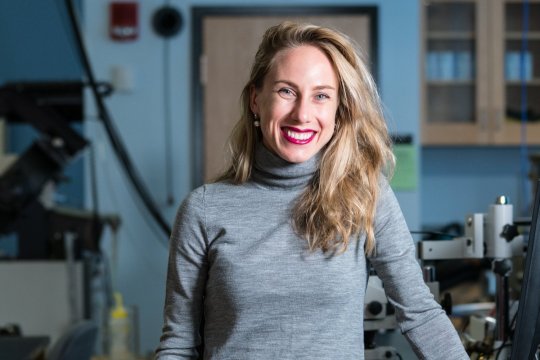

Polina Anikeeva PhD ’09, the Matoula S. Salapatas Professor at MIT, has been named the new head of MIT’s Department of Materials Science and Engineering (DMSE), effective July 1.
“Professor Anikeeva’s passion and dedication as both a researcher and educator, as well as her impressive network of connections across the wider Institute, make her incredibly well suited to lead DMSE,” says Anantha Chandrakasan, chief innovation and strategy officer, dean of engineering, and Vannevar Bush Professor of Electrical Engineering and Computer Science.
In addition to serving as a professor in DMSE, Anikeeva is a professor of brain and cognitive sciences, director of the K. Lisa Yang Brain-Body Center, a member of the McGovern Institute for Brain Research, and associate director of MIT’s Research Laboratory of Electronics.
Anikeeva leads the MIT Bioelectronics Group, which focuses on developing magnetic and optoelectronic tools to study neural communication in health and disease. Her team applies magnetic nanomaterials and fiber-based devices to reveal physiological processes underlying brain-organ communication, with particular focus on gut-brain circuits. Their goal is to develop minimally invasive treatments for a range of neurological, psychiatric, and metabolic conditions.
Anikeeva’s research sits at the intersection of materials chemistry, electronics, and neurobiology. By bridging these disciplines, Anikeeva and her team are deepening our understanding and treatment of complex neurological disorders. Her approach has led to the creation of optoelectronic and magnetic devices that can record neural activity and stimulate neurons during behavioral studies.
Throughout her career, Anikeeva has been recognized with numerous awards for her groundbreaking research. Her honors include receiving an NSF CAREER Award, DARPA Young Faculty Award, and the Pioneer Award from the NIH’s High-Risk, High-Reward Research Program. MIT Technology Review named her one of the 35 Innovators Under 35 and the Vilcek Foundation awarded her the Prize for Creative Promise in Biomedical Science.
Her impact extends beyond the laboratory and into the classroom, where her dedication to education has earned her the Junior Bose Teaching Award, the MacVicar Faculty Fellowship, and an MITx Prize for Teaching and Learning in MOOCs. Her entrepreneurial spirit was acknowledged with a $100,000 prize in the inaugural MIT Faculty Founders Initiative Prize Competition, recognizing her pioneering work in neuroprosthetics.
In 2023, Anikeeva co-founded Neurobionics Inc., which develops flexible fibers that can interface with the brain — opening new opportunities for sensing and therapeutics. The team has presented their technologies at MIT delta v Demo Day and won $50,000 worth of lab space at the LabCentral Ignite Golden Ticket pitch competition. Anikeeva serves as the company’s scientific advisor.
Anikeeva earned her bachelor’s degree in physics at St. Petersburg State Polytechnic University in Russia. She continued her education at MIT, where she received her PhD in materials science and engineering. Vladimir Bulović, director of MIT.nano and the Fariborz Maseeh Chair in Emerging Technology, served as Anikeeva’s doctoral advisor. After completing a postdoctoral fellowship at Stanford University, working on devices for optical stimulation and recording of neural activity, Anikeeva returned to MIT as a faculty member in 2011.
Anikeeva succeeds Caroline Ross, the Ford Professor of Engineering, who has served as interim department head since August 2023.
“Thanks to Professor Ross’s steadfast leadership, DMSE has continued to thrive during this period of transition. I’m incredibly grateful for her many contributions and long-standing commitment to strengthening the DMSE community,” adds Chandrakasan.
#000#2023#Administration#Alumni/ae#approach#bioelectronics#Brain#Brain and cognitive sciences#brain research#career#chemistry#communication#Community#competition#computer#Computer Science#devices#Disease#disorders#DMSE#education#Electronics#Emerging Technology#engineering#Faculty#fiber#fibers#focus#Ford#Foundation
0 notes
Text

Flexible, permeable and 3D integrated electronic skin combines liquid metal circuits with fibrous substrates
In recent years, research teams worldwide have been trying to develop new flexible and soft electronics. These devices could have various potential applications, for instance helping doctors to monitor their patients' health conditions or supporting rehabilitation and performance sports. To be safely and comfortably worn by users daily, these devices should be permeable (i.e., based on breathable materials that allow liquids and gases to pass through them). They should also be bio-compatible (i.e., safe to be worn on the human body for long periods of time) and strain resistant, meaning that they do not break easily when stretched or pulled in a specific direction. Researchers at the Hong Kong Polytechnic University and other institutes in China recently developed a new intrinsically permeable, 3D integrated and flexible electronic skin. This e-skin, presented in a paper in Nature Electronics, is based on high-density inorganic electronic components placed on organic stretchable fibrous substrates.
Read more.
12 notes
·
View notes
Text
Carbon Fiber in Electronics: Pros and Cons
Discover how carbon fiber is revolutionizing electronics! From enhanced durability to superior thermal management, explore the benefits and challenges of integrating this high-tech material into your favorite devices. Read more in our latest blog post.
https://www.nitprocomposites.com/blog/carbon-fiber-in-electronics
0 notes
Text
youtube
Old clothes and rags, each with special significance, woven into a technological carpet which can reproduce those memories through sound.
Using the Bela microcontroller and the Trill touch sensor package, alongside conductive e-textile fibers (so expensive! what a joy to use them again.) this carpet interfaces with a pure data patch to reproduce voice recordings of important memories. These sounds, however, are not perfect recollections, but are warped and cut apart fragments, partially forgotten.
By weaving these materials and sounds into this carpet, we've created a solidified memory. Now, without deluding ourselves into thinking we've made a perfect copy, we can hold what we remember of these memories in our hands, forever.
Created by Viktoria Angyal, Salma Aly, Maria Konstantinova, and me, Kathrine Hardman (in no particular order).
Produced as part of the Fashionable Technologies I course at Interface Cultures, taught by Malte Bergmann, and Maxi Fröbel. My special thanks go out to them :)
More info: minodu.notion.site/Carpet-of-memories-3f12110166254cb7beda6caf6b519c0a
1 note
·
View note